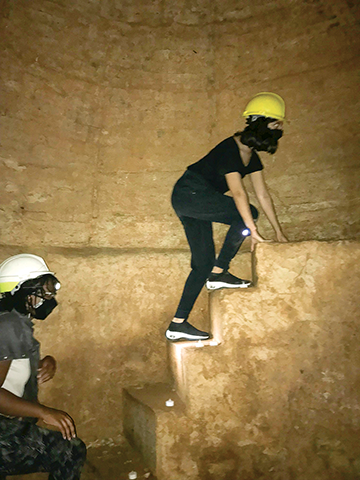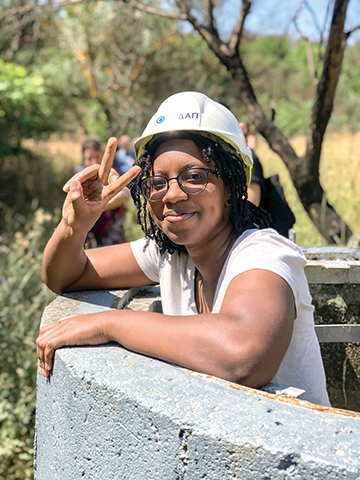From the Interim Provost
Atam P. Dhawan
Interim Provost and Senior Executive Vice President
Senior Vice Provost for Research
Distinguished Professor of Electrical and Computer Engineering
Building Resilience
Scientific Innovation for a Sustainable, Equitable Future
Learn MoreConstruction Engineering
Lab-Simulated Earthquakes - Test the Mettle of ‘High-Performance’ Building Materials
Learn MoreSustainable Design
Mapping an Ancient Solution to a Modern Crisis
Learn MoreEnvironmental Chemistry
The Rise of a Climate-Triggered Neurotoxin in the Arctic Tundra
Learn MoreNJIT in the World
Alumni Q&A
Learn MoreWater Remediation
Harvesting the Toxic Blooms of Summer
Learn MoreDiversity in Science
Shark Science
Learn MoreUndergraduate Research
From City Streets to Waterways, Undergraduates Use Data for Change
Learn MoreDefusing Disaster
Defusing Disaster
Learn MoreESSAY - Novel Building Materials
Converting Yesterday’s Rubble into Tomorrow’s Cities
Learn MorePower Electronics
Working the Wind
Learn MoreLanguage Development
Singing Lessons
Learn MoreApplied Optics
Tracking a Deadly Rise, Historic Fall of Insect Populations
Learn MoreEconomics of Recycling
New Futures for Old Plastics
Learn MoreCommunity-Engaged Architecture
Tiny Home Designs Offer Big Community
Learn MoreNew Faculty
New Faculty
Learn MoreFaculty Accomplishments
Faculty Accomplishments
Learn MoreResearch at NJIT: By the Numbers
Research at NJIT: By the Numbers
Learn MoreView and Download PDF
View or download the complete PDF.
Above: Georgeen Theodore stands near a wellhead in Athens. Theodore is creating a three-dimensional model of the city’s Roman-era aqueduct that could help citizens access its water and offset intense heat island effects.
Athens is dense, dry and prone to drought. Together, rising temperatures, a lack of trees and intense heat island effects are baking the modern metropolis of more than three million people. Researchers think a nearly 2,000-year-old answer to the city’s problems may lie beneath its streets.
In 125 CE, Roman emperor Hadrian ordered the creation of an aqueduct that eventually stretched more than 12 miles. Despite being abandoned decades ago, the aqueduct continues to function — silently collecting groundwater. The missed opportunity, however, is that the water is currently routed to a sewer and dumped into the Aegean Sea.
Georgeen Theodore, a professor at the Hillier College of Architecture and Design (HCAD) and the coordinator of the Master of Urban Design Program, wants the people of Athens to be able to access that water — and have a say in how it is used. She’s building a toolkit that will include a richly detailed, three-dimensional digital model of the aqueduct and its adjacent watershed that will help municipalities access the water flow, see how it intersects with the existing urban landscape and design public green spaces that can be irrigated. Creating these green pockets will help offset the heat island effects in a metropolis where the temperatures can reach
111 degrees.
Without a visual guide, municipalities have no way to manage or utilize the water, says Theodore, who started researching the underground system in 2017.
“We are using our skills as designers to make visible what is invisible and make it negotiable, and enable residents to help inform the design. We are using the skills of designers to help democratize a big infrastructure project. We want to make it understandable at a glance and create tools to help people see it.”
Theodore, a founder and principal of the architecture, urban design and planning practice Interboro Partners, says the toolkit will include diagrams and infographics that will help local stakeholders understand the Roman-era water system. She’s currently working with two students to “build a digital and a physical model of the aqueduct and prototypical sites where we can test public space interventions that lower temperatures.” The project is part of a collaboration among the city, the regional water authority, the city of Chalandri, the National Technical University of Athens and NJIT.
In 2022, Theodore and two of her students went to Athens for a week and had the “thrilling” experience of entering the aqueduct at multiple spots. Above ground, all one can see
are the wellheads.
“It was interesting to study something for a long time from afar and to then finally get to experience it in person. Climbing down into a deep, dark well that was built nearly 2,000 years ago was an extraordinary experience for me and my team. The fact that water still runs through the tunnels demonstrates the ingenuity of Roman design and engineering.”
Despite its significance as both a cultural artifact and an impressive feat of engineering, the fact that the aqueduct (and how it operates) are virtually invisible also makes it vulnerable to the risks of damage, pollution and depletion from above-ground urban land use. These vulnerabilities have been exacerbated over the past several decades, as urban development has resulted in several blockages in the aqueduct wells. The abandonment of its reservoirs has also led to unsustainable practices. For example, many communities in metropolitan Athens rely on the potable water from the mountains for irrigation, when non-potable water would be
a better choice.
The project won’t just close the gaps in understanding the system, but will develop an interactive digital archive to host new visualizations of the aqueduct and the integration of citizen science through community engagement and participation in the project’s development.
Two years ago, Theodore got seed grants from HACD and NJIT for the project. The Athens water and sewer company paid for her students’ travel to Athens. Those two students, Ebony Payne ’22 and Iman Syed ’22, worked with her last semester to build a digital and physical model of the aqueduct and prototypical sites where they can test ideas about cooling.
Theodore, who is also working on a project around cooling stations in the South Bronx with the New York City Health Department, says the research in Athens has applicability to the larger world. “Think about U.N. sustainability goal 11 —to make cities more sustainable. The heat island in Athens is extreme, but the issues we are grappling with are global,” she says.

Iman Syed ’22 ascends a staircase inside Hadrian’s Aqueduct beneath the city of Athens, while Ebony Payne ’22 looks on.

Ebony Payne ’22 prepares to climb out of the 2,000-year-old aqueduct.

A Room with a View
There’s a reason the daylight-filled corner office is a coveted prize for corporate achievers.
“A view from a window has a positive impact on emotions, cognitive performance and thermal comfort,” asserts Won Hee Ko, an assistant professor of architecture. Through experimentation, she seeks to quantify the benefits windows provide and to optimize the amount and quality of natural light that people receive throughout the day.
In her lab, Ko places sensors on the window and at eye and desk levels to measure how the conditions outdoors are filtered through it. She uses a fisheye camera lens to capture incoming visual information, including the level, distribution and color of light, as the human eye would.
“Specific bandwidths in the spectrum are directly related to mental and physical health. In keeping with circadian rhythms, we need more blueish light in the morning and less of it in the afternoon, for example.”
In a randomized study with 86 participants, she and collaborators at the Center for the Built Environment at the University of California-Berkeley found that in rooms with windows, people were happier, had increased working-memory and concentration, and felt cooler and more comfortable, even in slightly overheated spaces.
The latter finding has implications for sustainable design. “If having a view to the outdoors helps occupants increase their satisfaction with a wider indoor temperature range, then we could relax the temperature set points and reduce building energy consumption,” she notes.
In the absence of an established framework for guiding window design, she is developing evidence-based standards for what constitutes window view quality, including the content and clarity of what room occupants can see of the outdoors.
Her goal is to develop models that can simulate design
and view to optimize features such as building form, floor plan, orientation and glass selection, at the building and urban planning levels.
“We lack consensus on a unified definition for window view quality that is applicable across occupancies and building types,” she notes, adding, “But I believe windows
in everyday spaces should be a minimum design element.”
